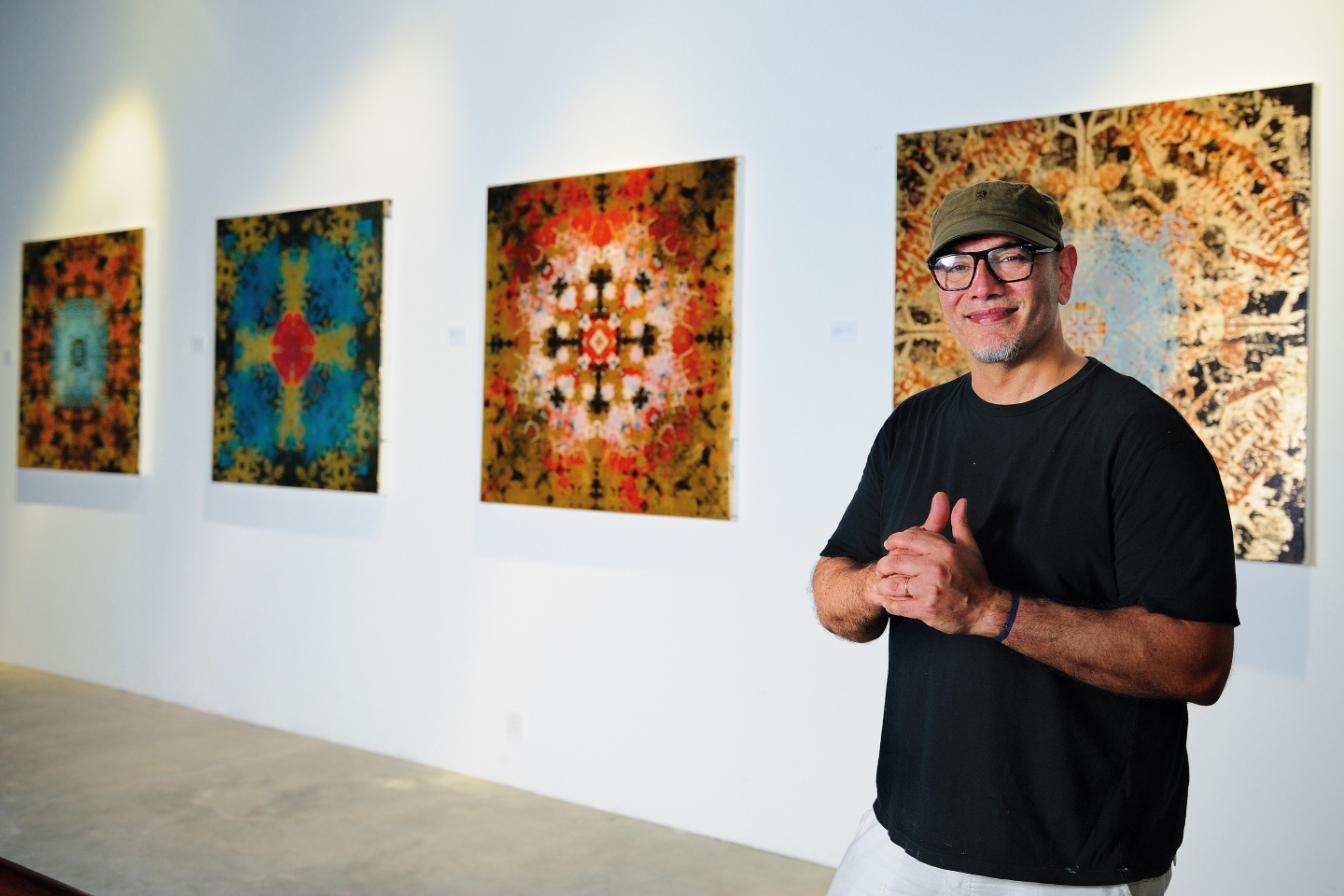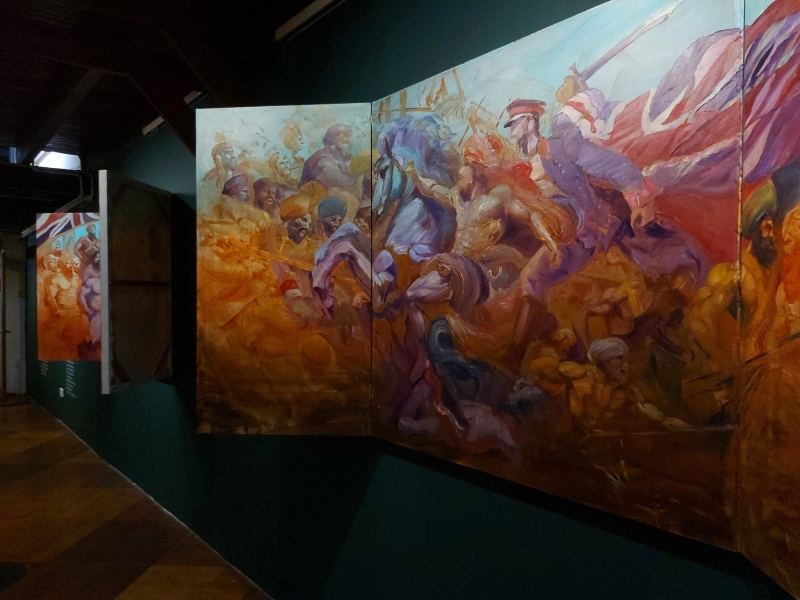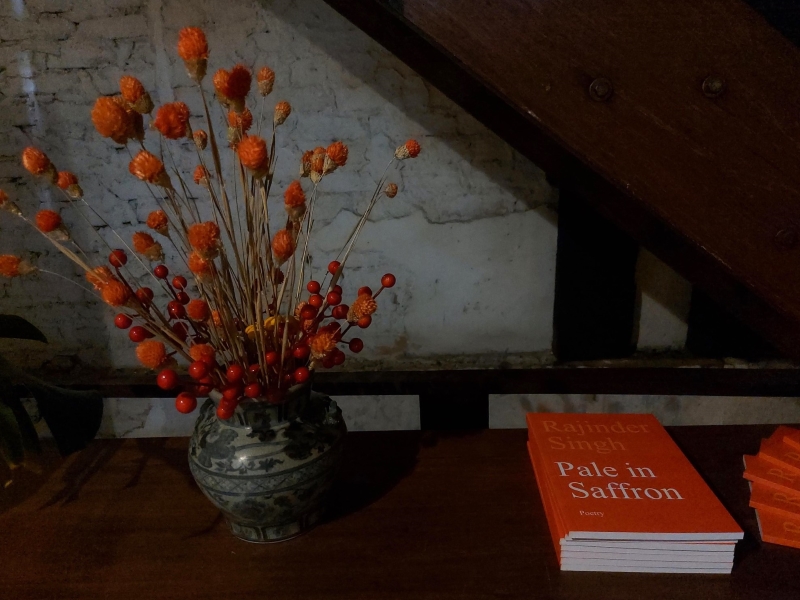
His latest series wrestles with the inheritances of colonialism through stories from his childhood in Ipoh (All photos: Wei-Ling Gallery)
Options: Congratulations on Saffron Surrender. Tell us a little of what to expect.
Rajinder Singh: I will be showing my latest series, which comprises nine large paintings alongside 23 new poems and two sculptures. Here, I wrestle with the inheritances of colonialism through stories from my childhood in Ipoh, passed on through generations and shared by the Sikh diaspora around the world. I take the title from the first of the stories, one that I remember told in fragments through the years — about the surrender on March 24, 1849, in Ferozepur in India’s Punjab, ending years of Anglo-Sikh wars, the story of objectification and humiliation by the British colonial forces of the Sikh body, which at once transformed the Sikh into prisoners and liberated as new colonial subjects.
Tell us also about the anthology of poetry you will be presenting concurrently.
Everything in Pale in Saffron — the lyrical essays, poetic fragments and poems — suggest a way out of hundreds of years of colonial rule. It is preoccupied with the choreography of colonialism and its inheritances. I start the book with the line, ‘We are caught in the curvature of receding minds’. I want my paintings, poems and sculptures to be a ‘call to action’ to escape captivity while the dead master’s voice constantly urges us to abandon rebellion, to recede into a world that stays within the confines of our past.
A previous exhibition was titled Saffron Songs. Tell us about this evolution in kesar.
I think of saffron not through the lens of the idea that is the saffron herb but as a colour that perhaps alludes to the weight of an idea, the idea of timeless eternity, the coldness of abstraction, the overflow of the infinite through the fabric of a turban. Perhaps I am pointing to the shade of the turban, which signifies martyrdom to some, to the racks of pain and certain death, or perhaps I am alluding to the idea of commemoration to those who sacrificed for the idea of something. With Saffron Songs and Saffron Surrender, I hint at what happens to a turban when it is not one, when it is a trap or a cage or a prosthesis to weightier things. Saffron has become the colour of my work as an artist, and it continually evolves, as does my practice.
455723562_1025539346244771_6919447485029255637_n.jpg

What or who were the key inspirations for this exhibition?
One of my main influences in both shows was the 17th-century Northern European painter Peter Paul Rubens. His dynamic, emotional style with its rich texture, vivid colour and lively movement has influenced my fast brushwork, prioritising movement and violence in my paintings of conflict and war. As a boy, like many Sikh kids around the world, I grew up with a living room full of prints of Sikh heroes in full battle gear in the midst of an all-out war.
You are based in London but grew up in Ipoh. What are some of your fondest memories of both cities?
I remember Ipoh for the education I received there. It seems to give you permission to explore and become … and it did this with a certain carelessness that I appreciate now. London is a city that espouses all my values and politics — it makes me want to be a better person, to respond to the call of activism, to make the world a better place for all.
You turn 60 this year. How are you marking this milestone occasion?
I am writing a book and I plan to have it worked out before I actually turn 60. All I really hope for is health and the opportunity to continue to create.
456032712_1025539432911429_2881245854019035360_n.jpg

What are you reading right now?
I am rereading Maroon Choreography by Fahima Ife. It connects with all my interests as a poet, choreographer and activist. I absolutely adore it.
What are you listening to right now?
I am a big fan of the English DJ and composer Fred Again. The music feeds my soul and I love his aesthetics and politics.
Describe your neighbourhood for us.
I live about 200 yards from the River Thames in the west of London, along the stretch where the Oxford-Cambridge boat races run once a year. It is a beautiful, central and diverse part of the world that also gives me quick access to the best museums and galleries.
What is your idea of a perfect weekend?
A home-cooked meal with my family, a walk along the promenade, time to myself to write, paint and create, and time spent with my girls playing poker or outside. We have wonderful friends in London and a great weekend will invariably constitute spending a few hours with them.
'Saffron Surrender' runs from now until Sept 14 at Wei-Ling Gallery, 8 Jalan Scott, Brickfields, KL.
This article first appeared on Aug 19, 2024 in The Edge Malaysia.


